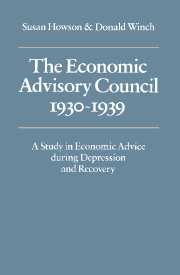2 - ORIGINS AND BACKGROUND
Published online by Cambridge University Press: 07 October 2011
Summary
As it finally emerged the Economic Advisory Council represented a compromise between two ideas which were first articulated during the latter half of the first world war as part of the general interest in ‘reconstruction’. The first of these ideas found expression in arguments for establishing what later became known as an economic general staff within the machinery of government, consisting of economists and statisticians acting as a regular organ of economic intelligence and advice. The second idea was more diffuse in character: it was advocated in several different guises during the inter-war period, but can be clearly recognised in its most influential form as a case for creating a national council composed mainly of employers' and trade union representatives drawn together in a deliberative assembly which could also serve as an advisory channel to the government on all matters affecting industrial relations as well as the wider issues of industrial and economic policy. While the former idea was largely administrative and technocratic in inspiration, though not, of course, without political significance, the latter entailed a combination of technocratic and representative elements.
Post-war reconstruction and the Committee of Civil Research
There is a long history of involvement by economists in the processes of official policy-making in Britain which goes back to the first half of the nineteenth century.
- Type
- Chapter
- Information
- The Economic Advisory Council, 1930–1939A Study in Economic Advice during Depression and Recovery, pp. 5 - 29Publisher: Cambridge University PressPrint publication year: 1977



